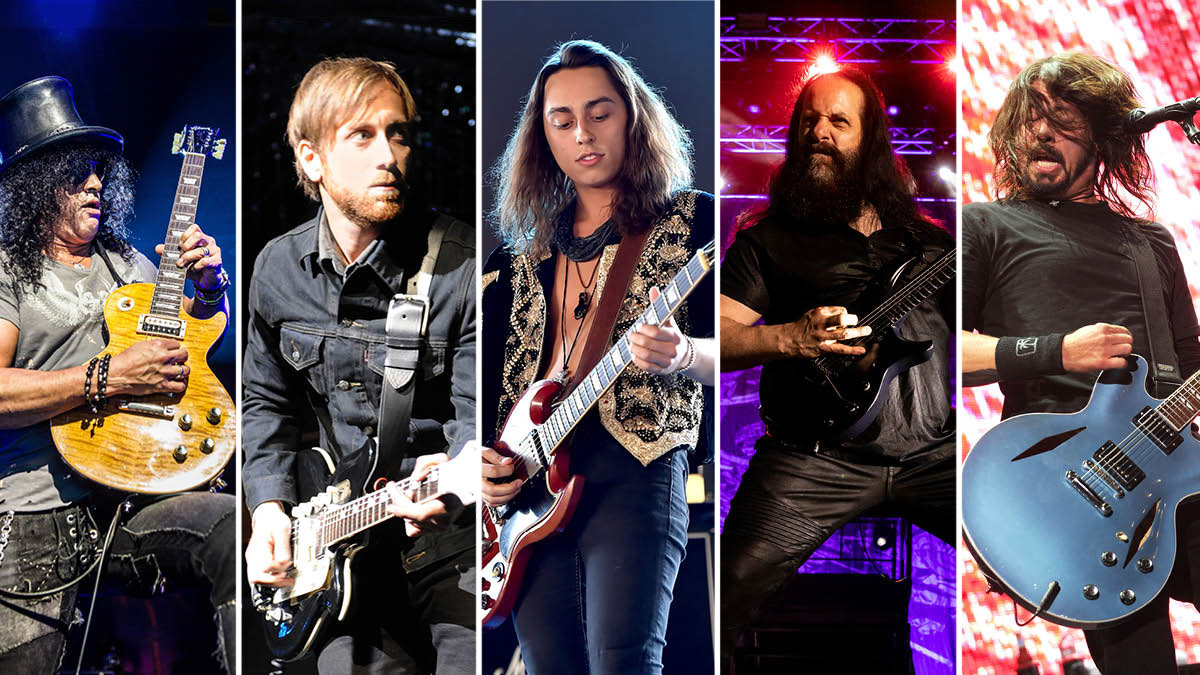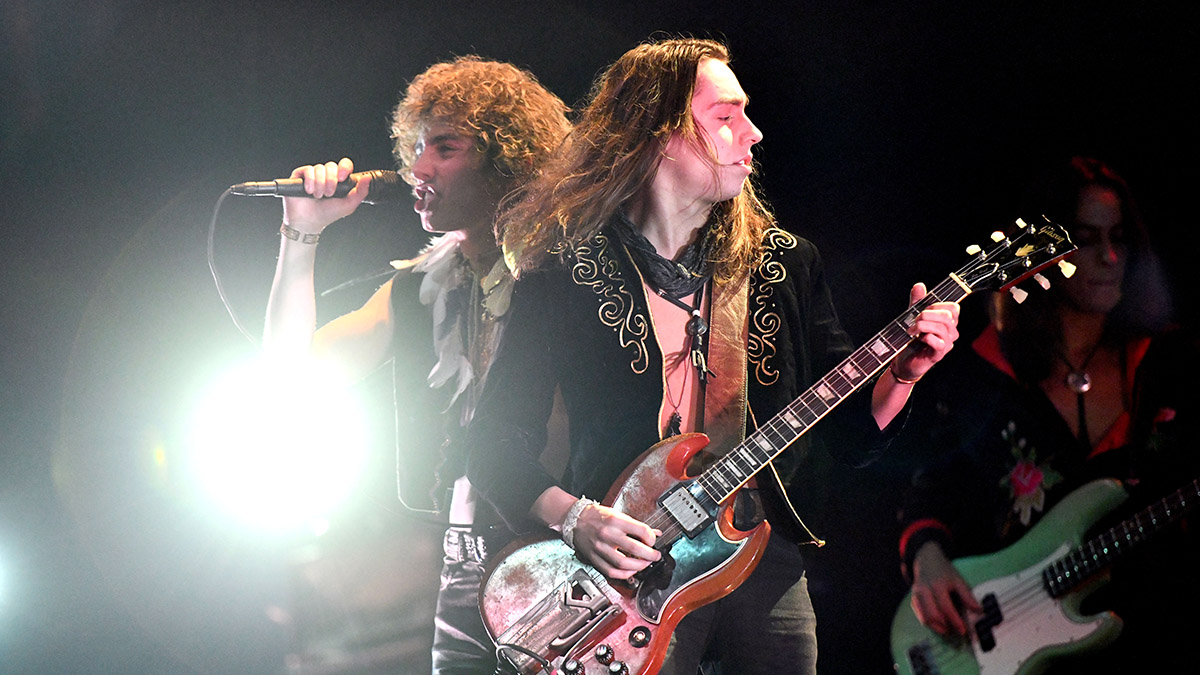The greatest guitar albums of the 2010s
A new generation of guitar heroes greets the stalwarts as we look at the decade's best albums from Slash, Ghost, The Black Keys and more – as voted by you

What can we say about the 2010s for guitar? There were modern classics from some of rock’s biggest names – Metallica, The Black Keys, Foo Fighters, Slash – and by then emerging guitar heroes including Ghost, Gojira and a young American band with a sound straight out of the early '70s…
These albums, the result of a popular vote hosted right here on Guitar World, arrive at a time when acoustic guitar playing was being taken into new frontiers by a trailblazing players using percussive techniques. And yet these – acoustic moments aside – are resolutely electric guitar albums, all made to be played loud.
Having brought you the greatest guitar albums of the ‘60s, ‘70s, ’80s,’90s, the 2000s, it’s time to turn the clock back a decade, and we'll kick it off at number 10 with a band who went all in on metal's sense of theater.
10. Ghost – Meliora (2015)
The title of Ghost’s third album roughly translates from Latin as “something better” – fitting for what band leader Tobias Forge conceived as a more guitar-driven opus.
Anonymity has always been at the core of Ghost’s self-made mythology, and while Forge has withheld the true identities of the ‘Nameless Ghouls’ who’ve handled guitar duties over the years, it is known that two Gibson SGs, a 1962 Les Paul and a Fender Telecaster were used in the making of Meliora.
Each guitar was fed through three different amps to create the album’s rich and impenetrably fortified wall of sound.
9. The Black Keys – El Camino (2011)
Dan Auerbach packed more catchy, feel-good riffs into El Camino than many bands can muster in an entire career. The Black Keys’ seventh album saw the duo of guitarist Auerbach and drummer Patrick Carney taking more cues from ’50s rock ’n’ roll than from the North Mississippi bluesmen that had inspired their earliest albums.
Get The Pick Newsletter
All the latest guitar news, interviews, lessons, reviews, deals and more, direct to your inbox!
Well known for using a pick and mix assortment of quirky guitars, Auerbach opted for a 1953 Les Paul for much of El Camino and employed some fun toys for the record’s stand-out guitar moments, including a pitch-shifter on Lonely Boy and a talk box for the solo on Money Maker.
8. Dream Theater – Distance Over Time
From a band of virtuosos, Dream Theater’s 14th album has all the chops that fans have come to expect: guitarist John Petrucci’s trademark displays of warp-speed technical ability and some head-scratchingly complicated time signatures. But in Distance Over Time there is heart as well as flash.
As Petrucci says: “You need to be able to play emotively, soulfully and beautifully just as well as you can play fast and technical.”
For the majority of the record, Petrucci used his DiMarzio pickup-equipped Ernie Ball Music Man Majesty, and coaxed from it both crystalline lead tones and snarling low-end filth.
7. Mastodon – Emperor Of Sand (2017)
Nobody does monolithic metal quite like Atlanta-based foursome Mastodon. Written in response to the real-life agony of multiple cancer diagnoses among the band’s nearest and dearest, Emperor Of Sand doubled down on despair, with the inevitability of death as its stark, central theme.
Forming one of modern metal’s greatest musical brotherhoods, guitarists Brent Hinds and Bill Kelliher’s labyrinthine rhythmic interplay is at its exemplary best across the entire collection of 11 conceptually connected tracks.
Testament to its masterful composition, the album was nominated for Best Rock Album at the Grammys and its lead single, Sultan’s Curse scooped the trophy for Best Metal Performance.
6. Rival Sons – Feral Roots (2019)
As its title suggests, Feral Roots was a primal, back-to-basics offering from American rockers Rival Sons. Written in a swamp shack in Tennessee after the band had returned from a supporting role on Black Sabbath’s farewell tour, the album is the band’s sixth – and their first for major label Atlantic, home to rock giants such as Led Zeppelin and AC/DC.
Although it’s peppered with acoustic moments, classic rock tones proliferate on Feral Roots, and Scott Holiday used a 50-watt Supro Statesman tube amp to carry the fuzz-filled riffs of cornerstone tracks like Do Your Worst and Back In The Woods.
5. Gojira – Magma (2016)
The sixth album from the French prog-metal pioneers marked something of a stylistic shift for Gojira. The band held back on some of the technical extravagances for which they’d become known in the past, including the normally ubiquitous ‘Gojira pick scrape’.
The result was a more broadly accessible, emotionally exposed and sonically streamlined record. And even with differently nuanced sides of Joe Duplantier and Christian Andreu’s playing on display in atmospheric numbers like Low Lands and the acoustic closer Liberation, staples of the Gojira sound still abound, with plenty of tricky time signatures and earth-shaking riffs throughout.
4. Metallica – Hardwired... To Self-Destruct (2016)
If Metallica’s 2008 album Death Magnetic was a somewhat laboured attempt at getting back to their thrash metal roots, Hardwired... To Self-Destruct, the long-awaited follow-up, was the record Metallica fans needed.
While its title evoked the internal tensions that had once threatened to end the band, the aggression in this album was directed outwards with high-octane thrashers like Spit Out The Bone and Atlas Rise! James Hetfield took charge of songwriting duties, while Kirk Hammett provided some of the wildest improvised solos he’s ever committed to record.
Sticking to favourite Gibson and ESP axes, the pair proved they didn’t need 7-string guitars or low tunings to deliver an output as heavy or as relevant as any modern metal outfit.
3. Foo Fighters – Wasting Light (2011)
With the aim of swerving the clinical sound of modern studio recordings, Foo Fighters’ seventh album served as a love letter to their alt-punk roots. Wasting Light was recorded in Dave Grohl’s garage, using only analogue equipment.
Produced by Butch Vig, the record packed all the rock ’n’ roll rawness and melodic highs that had first catapulted the Foos onto the airwaves in the 1990s. As well as Grohl’s ballsy rhythms (which he performed using his Gibson Trini Lopez guitars) and Chris Shiflett’s hooky leads, Wasting Light ushered in the return of Pat Smear as an official band member.
To give listeners a full earful of frequencies, Smear contributed lots of baritone guitar grit.
2. Slash – Slash (2010)
In the ’80s he made his name as a new guitar hero with Guns N’ Roses. In the ’90s he became leader of his own band, Slash’s Snakepit. In the 2000s he was part of the supergroup Velvet Revolver.
And in 2010 he delivered his first solo album – simply titled Slash. But while this remains the only record he has made under his own name alone, plenty of his famous friends were featured across its 14 tracks.
He called upon legendary rock vocalists including Lemmy, Ozzy Osbourne, Iggy Pop and Chris Cornell. There were some slightly eyebrow-raising collabs with pop stars, The Black Eyed Peas’ Fergie and Maroon 5’s Adam Levine.
Most significantly, there were two songs featuring Alter Bridge singer Myles Kennedy, with whom Slash would form a long-standing relationship alongside backing band The Conspirators.
And to top it all off, the album also featured everyone but Axl Rose from the classic Guns N’ Roses line-up. And yet, far from being outshone by this star-studded cast, Slash delivered on everything fans have come to know and love about his guitar playing, with chunky groove-laden riffs and epic wailing solos in abundance.
Gear-wise, he didn’t indulge in much experimentation, but really – why would he mess with such a classic sound? Rich Les Paul and Marshall JCM800 tones run throughout, with smatterings of wah here and there, and a few clean tones and acoustic guitars for contrast.
1. Greta Van Fleet – Anthem Of The Peaceful Army (2018)

By the time the Michigan-based band of (mostly) brothers were preparing to make their first full length studio album, Greta Van Fleet already had two celebrated EPs under their belt, and their singles Highway Tune and Safari Song had both perched atop Billboard’s Mainstream Rock charts in the USA.
Their rise had been meteoric, but had also attracted more than its fair share of burdensome remarks. One side of the music press hailed Greta Van Fleet as the next great saviours of rock’n’roll, while claims that the band were little more than a Led Zeppelin rip-off act bounced around like heckles hurled from the darkest corners of a crowded concert hall.
When Anthem Of The Peaceful Army dropped in October 2018, it sold over 80,000 copies in the first week and debuted at number 3 on the US Billboard 200. Its collection of rambunctious rockers and pastoral acoustic numbers demonstrated the band’s ability to rise above the chatter and simply do what they do best: make great rock music.
Guitarist Jake Kiszka reflects: “The objectives really were to create something raw and organic. There was nothing else out there quite like it at the time. Even now, it stands independently from that decade – specifically as very guitar-driven rock’n’roll music.”
The record’s widespread, intergenerational appeal perhaps boils down to the fact that Anthem Of The Peaceful Army captured a sound that feels simultaneously refreshing and revivalist. It’s a sound no doubt informed by the classic rock titans of yesteryear, but powered by the animate force of the band’s youth.
“I suppose it was a collection of many of the things that we’d created musically at the time,” Jake says. “We’d been a group for a while, and we’d been building a sonic direction and a spectrum of sound. It all came to one point on Anthem Of The Peaceful Army.”
The boys cut the record at Blackbird Studios in Nashville in what would turn out to be a particularly prolific session.
“We were exploding with creativity,” Jake recalls. “It was interesting because we did bring a handful of material and had everything mapped out, but it turned out that being in a certain environment catered to the essence of off-the-cuff creativity.”
With previously penned tracks out the window and fresh ideas whirling around the studio, the band began tracking what Jake describes as “a seemingly limitless list of songs and musical concepts” the good old fashioned way – with everyone in one room, all playing together. “I think a lot of that live energy translates,” he says with satisfaction.
We left with a lot of material that didn’t even make the record that was revisited and given a different life when we developed The Battle Garden’s Gate
Jake Kiszka
Testament to the abundantly creative headspace the band found themselves in, not only were they able to produce 10 killer tracks – plus a bonus, extended version of Lover, Leaver (Taker, Believer) – for Anthem, but they took home the seeds that would germinate into their next great record.
“Through the course of jamming and all the time that we had in the studio, there were tons of extra musical bits,” Jake says. “We left with a lot of material that didn’t even make the record that was revisited and given a different life when we developed The Battle Garden’s Gate.”
Jake brought longtime staple of his live and recording rigs into the studio – his trusty 1961 Gibson Les Paul SG. To clarify a little, the guitar has the SG shape, but still sports the ‘Les Paul’ name because it was made during the time when Gibson hadn’t quite ironed-out the finer details of its nomenclature after introducing the SG as the double-cut successor to the Les Paul.
Still equipped with its original stock PAF humbuckers, it’s Jake’s number one for a breadth of different tones and tasks. “It’s sort of a default for me,” he explains. “If I’m working with a bunch of different guitars not getting what I want, I can go there and know that I can achieve what I’m hearing in my head.”
This being said, Jake’s mind was open to exploration. He recalls: “The beautiful thing about getting in the studio for me is that I’m not using anything that I’m particularly familiar with, which sort of gives me a wider range of creative elaboration. I get to pick up a guitar I’ve never picked up before and see what happens.”
For one of the record’s stand-out tracks, Watching Over, he did just that, and grabbed a nearby Coral Electric Sitar to try out on the song’s intricate, mystically tinged solo. Not one to overthink a good thing, he laughs: “It was really cool, so I just kept it.”
The coolest part of picking up a guitar that I’m maybe unfamiliar with is that it sort of guides my hand and forces me to play in an alternative way
Of course, the resulting sound has those late-60s bohemian associations, but as Jake postulates, “The coolest part of picking up a guitar that I’m maybe unfamiliar with is that it sort of guides my hand and forces me to play in an alternative way.”
The sitar wasn’t the only example of this. “There’s a Telecaster on that record as well, which I’ve never talked about much,” he reveals with the sort of glee you might expect from a magician upon giving up his secrets.
Tonally, it’s a very different beast to his usual weapon of choice, and he explains how the switch from Gibson to Fender – and from humbuckers to single coils – wasn’t quite as radical a leap from his normal palette of influences as it might at first seem. “Some of the sonic associations with it were the British Invasion. You know, really early stuff like Jeff Beck and Page. Even Clapton. Those were some of the reference points for me.”
Fittingly, for a rock album recorded in the world capital of country music, and at a studio that’s seen the likes of Dolly Parton, Tim McGraw and Sheryl Crow pass through, he adds, “There’s also this early American country music association as well, so it was somewhere in between.”
Similarly, there were also British and American forces at work in the amp department, and Jake used a 1960s Vox AC30 as well as a selection of Marshall and Fender amps that the studio’s owner, John McBride, had to hand.
With little else in the way of pedals and effects, the timeless sound of gutsy riffs and lofty solos played through cranked valve amplifiers is what characterises much of the album. Simply, “the goal was to make it very stripped and very naked, in that sense.”
The spirit of simplicity was by no means extended to the actual playing, however. Jake shows off his considerable slide chops on Mountain Of The Sun, performs the catchy yet complex riff of When The Curtain Falls with precision and grit in equal measure, and his incendiary solo on Lover, Leaver is again reminiscent of Jimmy Page at his eyes-shut, spontaneous best.
As for the performance he’s personally most proud of, Jake singles out the epic Brave New World. “It’s one of my favourites because of the type of guitar playing. It’s very interesting and very avant-garde. I was sort of going out of my way to do something that no other guitar player would do – just making it strange intentionally.”
Since graduating university with a degree in English, Ellie has spent the last decade working in a variety of media, marketing and live events roles. As well as being a regular contributor to GuitarWorld.com, she currently heads up the marketing team of a mid-scale venue in the south-west of England. She started dabbling with guitars around the age of seven and has been borderline obsessed ever since. She has a particular fascination with alternate tunings, is forever hunting for the perfect slide for the smaller-handed guitarist, and derives a sadistic pleasure from bothering her drummer mates with a preference for wonky time signatures.



![[from left] George Harrison with his Gretsch Country Gentleman, Norman Harris of Norman's Rare Guitars holds a gold-top Les Paul, John Fogerty with his legendary 1969 Rickenbacker](https://cdn.mos.cms.futurecdn.net/TuH3nuhn9etqjdn5sy4ntW.jpg)







